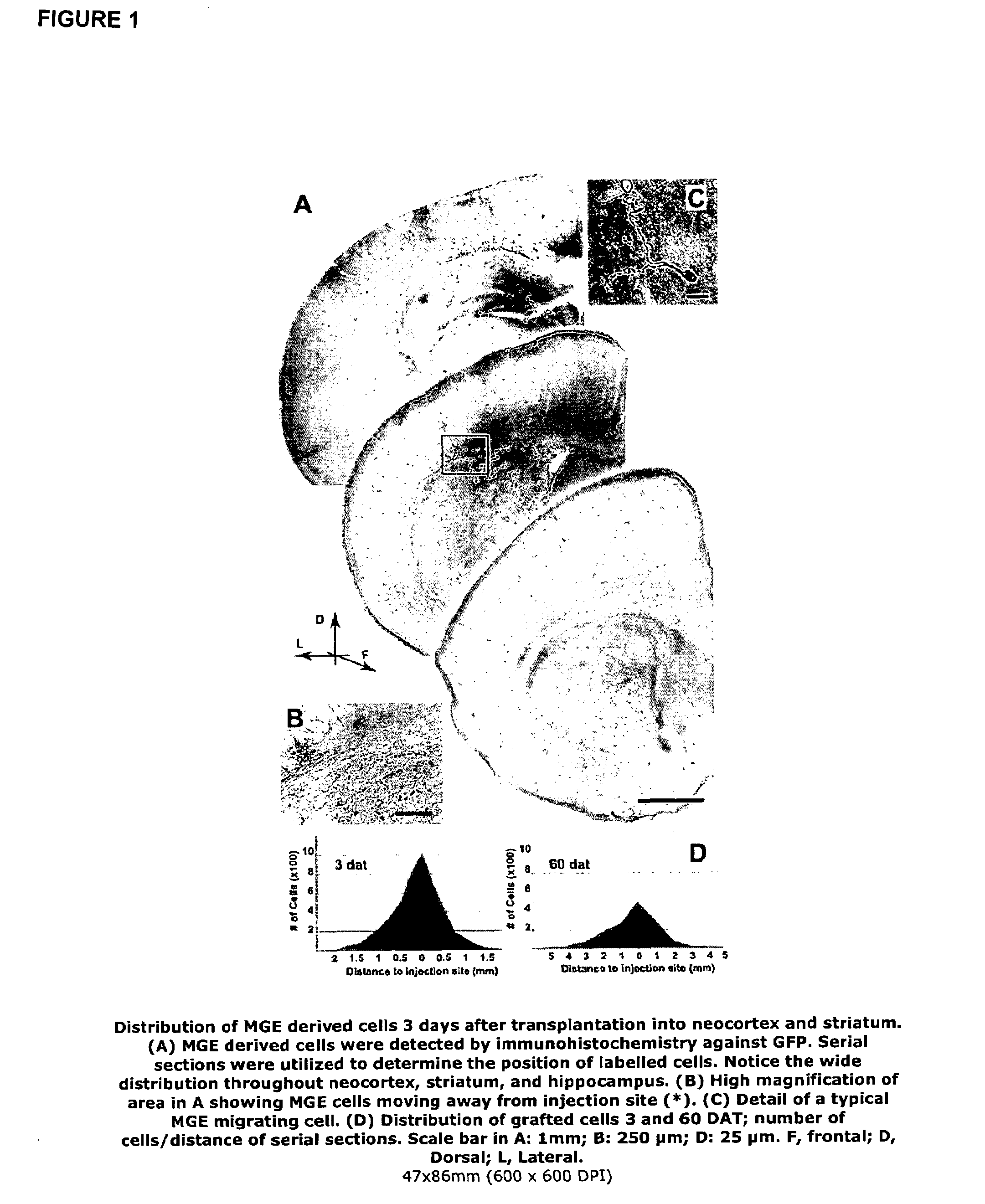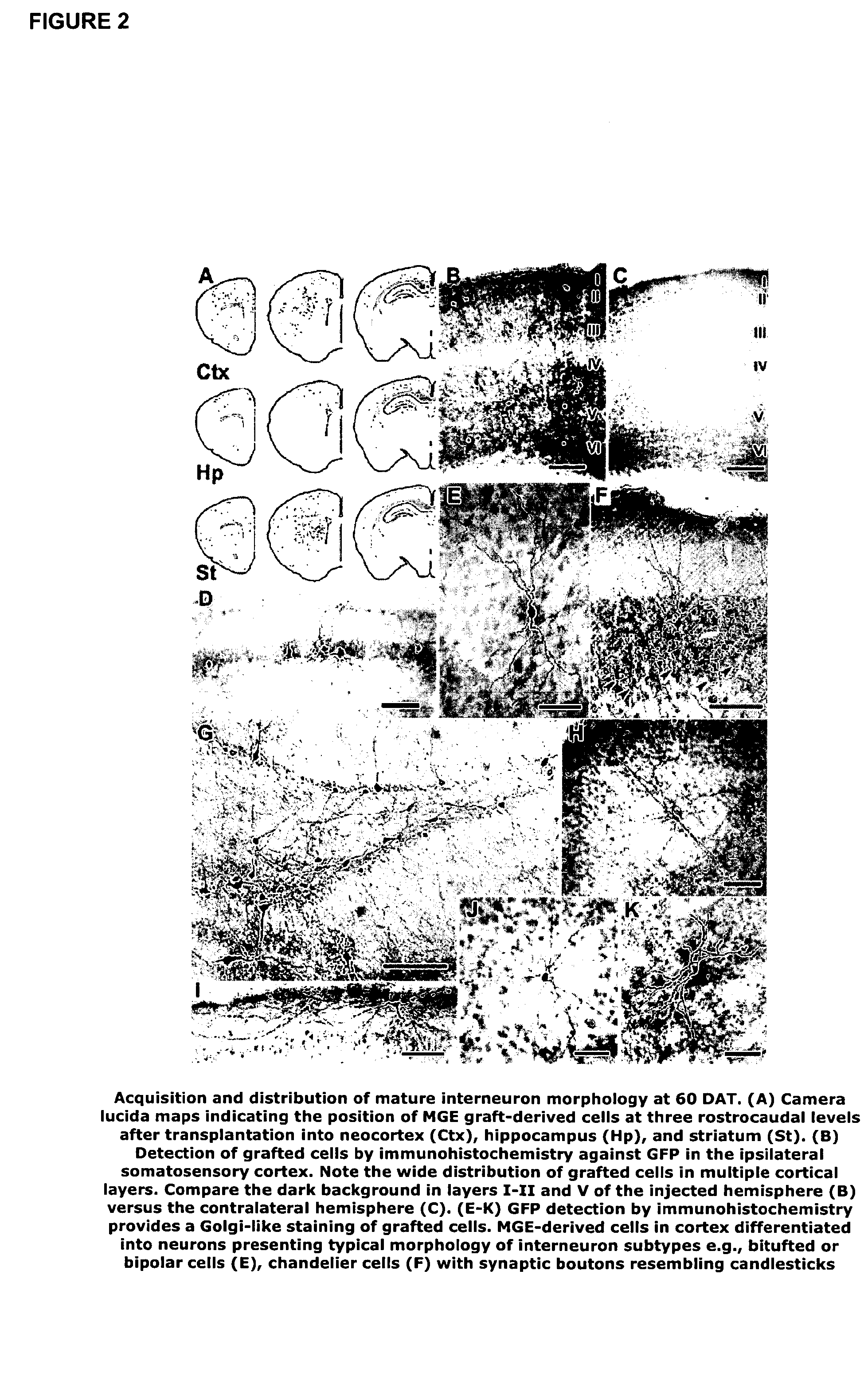Transplantation of neural cells
a neural cell and transplantation technology, applied in the field of transplantation of neural cells, can solve the problems of reducing vitality and sleep or rest, imposing an annual economic burden, and severe degradation of quality of life, and achieves the effects of increasing the levels of neurotransmitters such as gaba in the brain, enhancing inhibitory interneuron activity, and reducing the number of induced somatosensory abnormalities
- Summary
- Abstract
- Description
- Claims
- Application Information
AI Technical Summary
Benefits of technology
Problems solved by technology
Method used
Image
Examples
example 1
[0058]MGE cells were transplanted from mice expressing green fluorescent protein (GFP) into the postnatal brain. The time course of migration and differentiation of these neuronal precursors was determined. Also the molecular phenotype of transplanted MGE precursors was analysed using antibodies directed against GABA, somatostatin (SOM) and neuropeptide Y (NPY). Using cortical slices from grafted animals we showed that MGE-GFP neurons exhibit intrinsic firing properties similar to fast-firing basket-type cortical interneurons. Electrophysiological measurements demonstrate that MGE-derived neurons increase the level of GABA-mediated synaptic inhibition, and therefore appear to modify neocortical inhibitory tone.
Materials and Methods
[0059]Tissue Dissection and Cell Dissociation. Ventricular and subventricular layers from the anterior part of the medial ganglionic eminence, where a sulcus clearly divides medial and lateral ganglionic eminences, were dissected from E12.5-E13.5 embryonic...
example 2
Robust Epileptiform Burst Activity is More Difficult to Initiate in Slices Containing MGE Progenitors
[0079]Attempts are made to elicit epileptiform burst activity in cortical slices having received MGE progenitor cell grafts and control cortical slices that have not received MGE progenitors. It is determined to be more difficult to initiate robust epileptiform burst activity in slices containing MGE progenitors. This finding supports that MGE progenitors migrate and differentiate into functional interneurons in the host brain (and thus increase synaptic inhibition).
[0080]Neocortical slices are prepared from wild-type mice with MGE grafts and age-matched controls. Spontaneous seizure activity is initiated in neocortical slices by raising the extracellular level of potassium, in a step-wise fashion, from 3 to 6 to 9 mM [K+]e. Previous studies in our laboratory (Baraban and Schwartzkroin, Epilepsy Res. 1995 October; 22(2):145-56) and others (Rutecki et al., J. Neurophysiol. 1985 Novemb...
example 3
[0083]Seizures are more difficult to initiate in mice receiving MGE progenitors. Following bilateral MGE grafting in wild-type mice (and sham operated controls; young adult P30 and adult P60 ages) EEG electrodes are implanted bilaterally in neocortex and animals monitored with video-EEG. After a 1 wk recovery period, following surgery, animals are injected with kainic acid (KA, a glutamate receptor agonist) at a concentration previously shown to elicit status epilepticus in the mouse e.g., 30-40 mg / kg i.p. (Baraban et al., Brain Res Dev Brain Res. 1997 Sep. 20; 102(2):189-96; Baraban et al., J. Neurosci. 1997 Dec. 1; 17(23):8927-36). In analyzing video-EEG traces following initiation of a KA-induced seizure, the frequency and duration of electrographic seizure events recorded are quantified. Behaviors that accompany these discharges are fully characterized by close examination of the video-EEG recordings using an investigator blind to the status of the animal. Clinician-scientists i...
PUM
 Login to View More
Login to View More Abstract
Description
Claims
Application Information
 Login to View More
Login to View More - R&D
- Intellectual Property
- Life Sciences
- Materials
- Tech Scout
- Unparalleled Data Quality
- Higher Quality Content
- 60% Fewer Hallucinations
Browse by: Latest US Patents, China's latest patents, Technical Efficacy Thesaurus, Application Domain, Technology Topic, Popular Technical Reports.
© 2025 PatSnap. All rights reserved.Legal|Privacy policy|Modern Slavery Act Transparency Statement|Sitemap|About US| Contact US: help@patsnap.com



